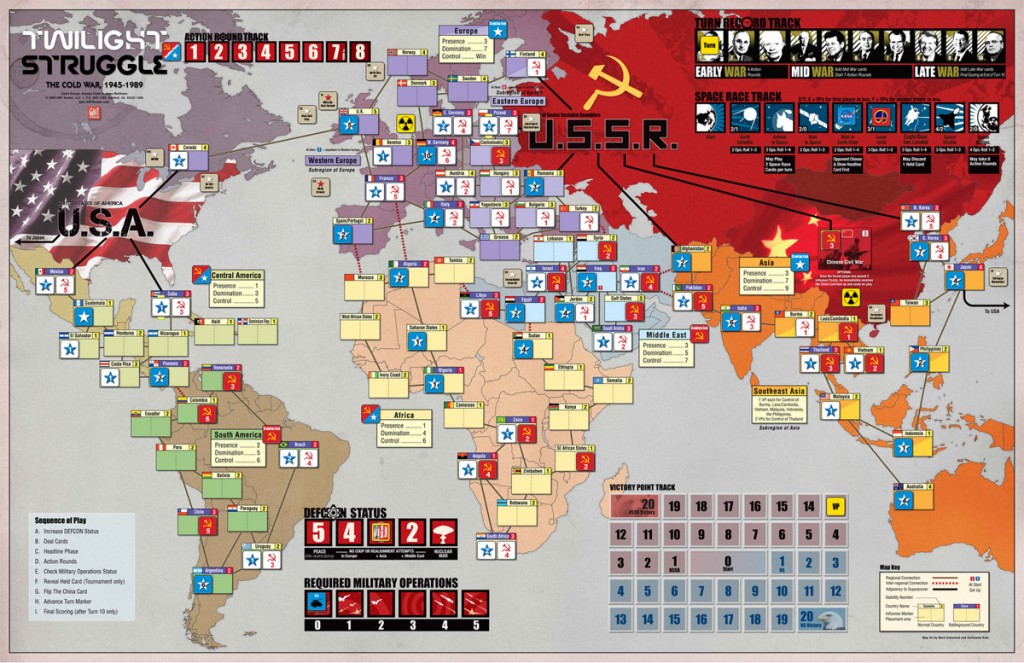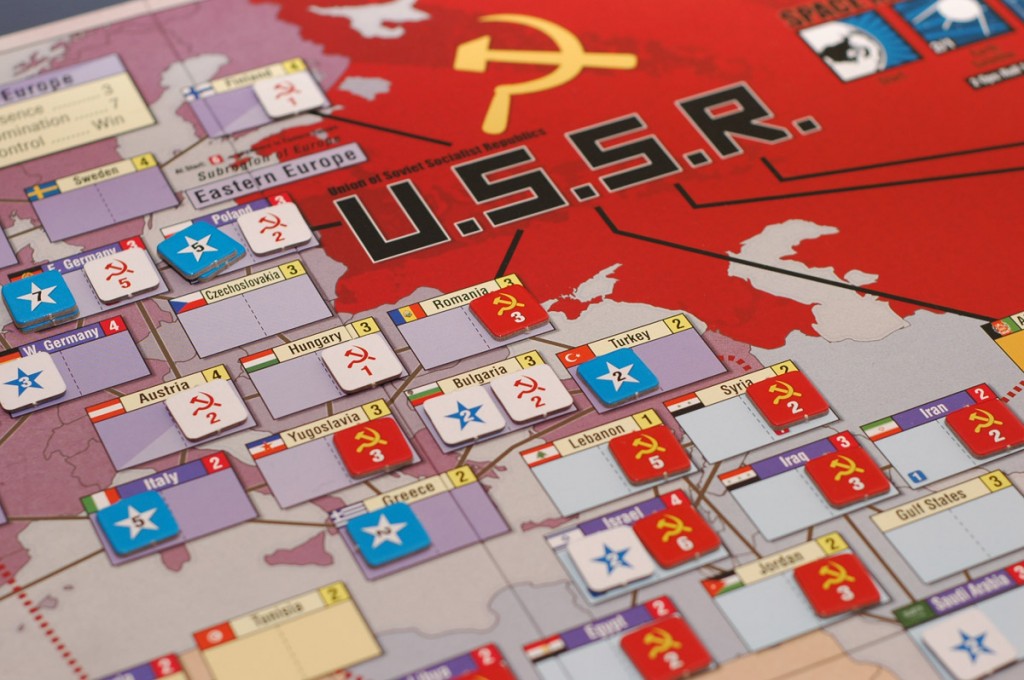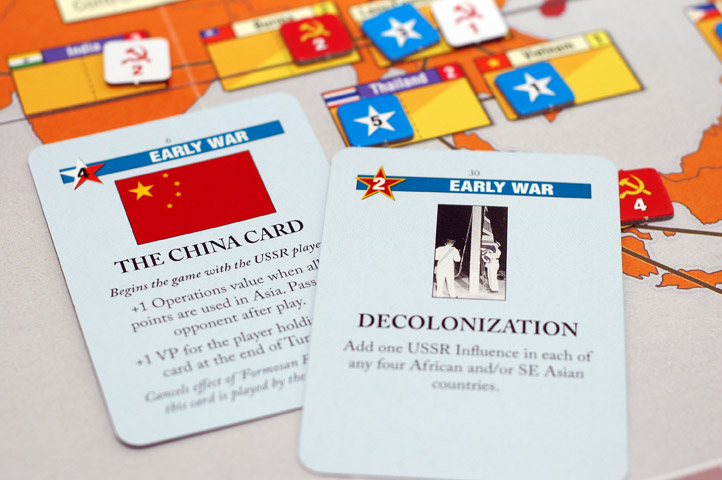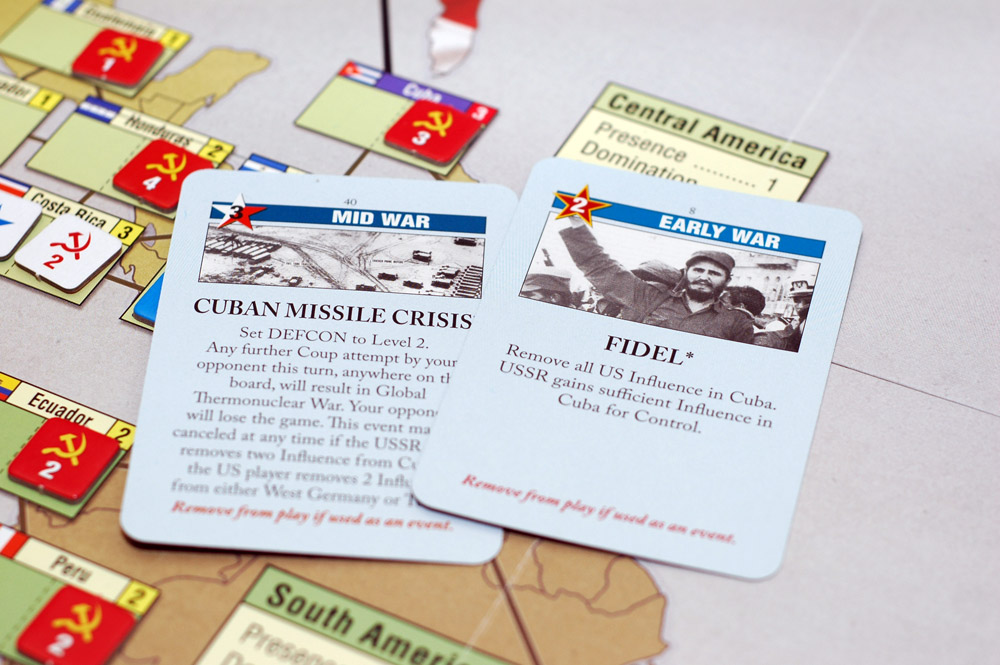“Russians don’t take a dump, son, without a plan.” – Admiral Painter, The Hunt For Red October

A funny thing happened in the world of board gaming on Dec. 9, 2010; the top-ranked game for the better part of 7 years running on BoardGameGeek was usurped by a very unlikely candidate – Twilight Struggle, a massively strategic, chit-laden, brain-grinding, two-player game about the Cold War, released in 2005. Huh. And this is why I love the board gaming community. This is also why, four hours after learning the news, I walked out of my favorite local game store with Twilight Struggle under my arms and my wife and I proceeded to get about 4 hours sleep over the next five days.
Upon opening the heavily-compacted box, we discovered that there were about 1,687,241 little cardboard chits, divided amongst two cardboard sheets. While the wife practiced her chit-punching skills, I dove into the rulebook. The instructions read like the missile codes for silo 237 near Tribune, Kansas, or the operations manual for a 1968 Dodge Dart. There were numbers everywhere, and every single line in the rulebook is coded so that rules earlier or later in the rulebook can use this code for cross-referencing. It’s all a bit reminiscent of a large-print Bible or the 8 volume statute laws for housing in Brooklyn, and can be a bit intimidating. Luckily, this was not my first “war” game, and so the concepts were far from alien.
After about an hour of surveying the territory and going over the rules for the third time, the wife took on the side of the free world, while I readied the Red Tide. After that first game, I was tempted to call the game Twilight Imperium Struggle because of its length. That first game took us almost 3 hours, and we only made it to round 5. Things seemingly got better when our second game ended at round 6 and it only took us 1.5 hours. Of course, that’s when we realized that we had missed rule 23.1.10.z.5x.B that made the game much, much more complex.
Despite the thickish, cross-indexed rulebook, the underlying gameplay and concepts of Twilight Struggle are fairly simple. The period of play begins at the end of World War II, as Germany is split between Soviet and US occupation; the two players of the game assume the roles of these burgeoning superpowers. The game is broken into ten rounds, each representing a particular span of time in the Cold War, ending in 1989. The goal of the game is to spread enough influence throughout the world to become the reigning superpower by the end of round 10.
OPERATIONS
Each player spreads influence and affects their standings in the world through play of cards that are received each round. Every card contains a starred number, the color of which indicates which side benefits from the event listed on the card, should that event be activated. The number represents how many Operations (Ops) Points that card provides the player when the card is put into play. These Operation Points can be used in various ways to try and control a country and therefore score more points in that region when the region is scored.
Operation Points may be used in the following ways:
- INFLUENCE. Ops Points are used to Influence a country for control. If a country contains no influence of another superpower, then the player may place one Influence Point per Ops Point spent. When that player has an equal or greater amount of Influence than the country’s Stability score, then that player controls the country. When a country is controlled by another superpower, cost of another player placing influence there is doubled.
- REALIGNMENT ROLLS. These high risk, high yield rolls are used to reduce the amount of Influence an opponent has in a country while raising the player’s own. The risk is that, with a bad die roll, the opponent may gain more Influence there than was present previously.
- COUPS. In a coup, a player uses Ops Points to boost a die roll in an effort to use military force to take control of a country. The outcome of a coup is more easily controlled than a realignment roll, but attempting coups on “battleground” countries will cause the Defcon level to drop. When the world hits Defcon 1, nuclear war breaks out and everybody loses. This is, of course, a very bad thing.
EVENTS
Each card, with the exception of Scoring cards, is also playable as an Event. If the color of the numbered star matches the player’s superpower – blue for the US and red for the USSR – then that player may opt to activate the event associated with the card, instead of using the number inside the star as Ops Points. When played, the effect on the game is thematically tied to the event, creating not only a reason for the event, but also a close tie to the overall theme. For instance, the Fidel card allows the Soviet player to take control of Cuba. This card is an Early War card, which means that it comes into play within the first three rounds of the game.
If a card displays a numbered star with a color opposite of the player’s superpower, then that Event is activated if the player uses the card for Ops Points. The good news is that the player receives some Ops Points – the bad news is that your opponent is going to get a nifty little bonus with which you’ll have to contend.
SCORING
Mixed in amongst the Event cards are certain Scoring cards which, when played, force players to tally up controlled countries in a certain region and determine scores. Typically, players will have one or two cards left over each round that they can hold in their hands to the next round, hoping to make a big play or minimize the effects of a particularly nasty Event that will benefit their opponents. Scoring cards cannot be held from round to round; all Scoring cards must be played before the end of the round, even if that means holding onto cards that may help a player to gain more Influence.
STRATEGY
Twilight Struggle is all about balance – how best to keep your Influence spreading in the world while containing your opponent’s Influence, matching lost Scoring opportunities, minimizing the effects of detrimental Events, and figuring out the right mix of long-term strategy with immediate tactical play. Here are a few key points that are essential for solid play in Twilight Struggle:
- EVENT MANAGEMENT. Each player will typically find a healthy mix of both red and blue cards in their hand each round, so it is essential to calculate when to play a card that will trigger an Event that is detrimental to your superpower and then diffusing the effects of that card through clever use of Ops Points.
- THE SPACE RACE. Each superpower can discard card(s) of a certain Ops Point value to try to advance in the Space Race each round. By advancing, the player can gain both victory points and/or special abilities, as well as get rid of a card that would trigger a particularly nasty opponent’s Event.
- PATIENCE AND DILIGENCE. This game is mostly a struggle for the US player. US players must not get discouraged. Just like in the real Cold War, the Americans are up against a Red Tide and they have to stick it out for the long war. My wife and I have played Twilight Struggle over eight times now, and each time the US has lost to the Soviets; however, each time the strategy of the US become clearer and clearer. It is very important for the US player to make wise tactical decisions in the early game to contain the Soviets, then focus on their long-term plans for scoring around mid-game as the mix of helpful US Events will begin to outweigh the strong Soviet Events from the Early War. The last game my wife and I played I managed to take the US all the way until the final round and then eventually lost in final scoring because of a tactical error in Europe in round 8. Had I stayed completely focused on controlling Europe, I likely would have celebrated as the Berlin Wall fell.
Overall, Twilight Struggle can be a grueling, grinding experience, but the end rewards are rich. Rarely have I played a game more balanced in strategy and tactics, where every decision is crucial. The mechanics of the game are incredibly tight, which, when combined with abilities and historical flavor of the cards, can create a truly immersive experience.
One of the game’s amazing qualities is how well the cards and the situations around the board can recreate history; at one point, my wife and I spent almost an entire round fighting a long, prolonged struggle for influence over Cuba while the Cuban Missile Crisis loomed. In a later game, we fought vehemently for control of East Germany at about the time that Reagan asked for Gorbachev to tear the wall down. It is this attention to detail and the resulting gameplay which makes you feel as though you are not only living history, but influencing it, that makes Twilight Struggle transcend the ordinary and chronicle this extraordinary period of the 20th century all in the placement of a single chit and the smooth roll of a die.
| Gameplay/Replay | Components & Theme | Fun |
|---|---|---|
 There's barely another adjective that can express Twilight Struggle's gameplay other than intense. For the 3+ hours of a typical game, your mind is on full throttle the entire time. The game is fully card-driven, which makes for a very immersive, unique and variable experience. This variability also lends the game a very high replay value. Rarely has any round of the game that we've played been the same, and that bodes well for those who relish the challenge this game offers. There's barely another adjective that can express Twilight Struggle's gameplay other than intense. For the 3+ hours of a typical game, your mind is on full throttle the entire time. The game is fully card-driven, which makes for a very immersive, unique and variable experience. This variability also lends the game a very high replay value. Rarely has any round of the game that we've played been the same, and that bodes well for those who relish the challenge this game offers. |  The board is massive, and the wave of chits that cover its breadth impressive. The colors are limited, but magnificent, nonetheless. It's very easy to see the scope of the situation at any given moment given the components. The theme is inherent in almost every conflict, card and decision; the game plays out the events and hard tactics of the actual Cold War so perfectly, it would have saved everyone a lot of trouble had it been invented in 1945. The board is massive, and the wave of chits that cover its breadth impressive. The colors are limited, but magnificent, nonetheless. It's very easy to see the scope of the situation at any given moment given the components. The theme is inherent in almost every conflict, card and decision; the game plays out the events and hard tactics of the actual Cold War so perfectly, it would have saved everyone a lot of trouble had it been invented in 1945. |  Judging this category is difficult for Twilight Struggle. Is the game fun? In the traditional sense - where you all sit around and laugh at the misfortune of Johnny Adderall or the silly answer that your Aunt Sally gave in Trivial Pursuit - Twilight Struggle can't even register on the same scale. The game is an entirely different animal; the fun in reenacting the Cold War lies in the experience and the thrill of matching wits with a wily and often devastatingly offensive opponent. Much of the fun comes in the long, detailed analysis in which you and your opponent will engage after the battle is long over. Despite the long conflict and sometimes-fatigue-inducing gameplay, even the most devastating defeat will leave you clamoring for more. That's not addiction, or hubris - that, my friends, is pure, unbridled love for a game and of The Game. Nothing can be more fun than that. Judging this category is difficult for Twilight Struggle. Is the game fun? In the traditional sense - where you all sit around and laugh at the misfortune of Johnny Adderall or the silly answer that your Aunt Sally gave in Trivial Pursuit - Twilight Struggle can't even register on the same scale. The game is an entirely different animal; the fun in reenacting the Cold War lies in the experience and the thrill of matching wits with a wily and often devastatingly offensive opponent. Much of the fun comes in the long, detailed analysis in which you and your opponent will engage after the battle is long over. Despite the long conflict and sometimes-fatigue-inducing gameplay, even the most devastating defeat will leave you clamoring for more. That's not addiction, or hubris - that, my friends, is pure, unbridled love for a game and of The Game. Nothing can be more fun than that. |




Comment